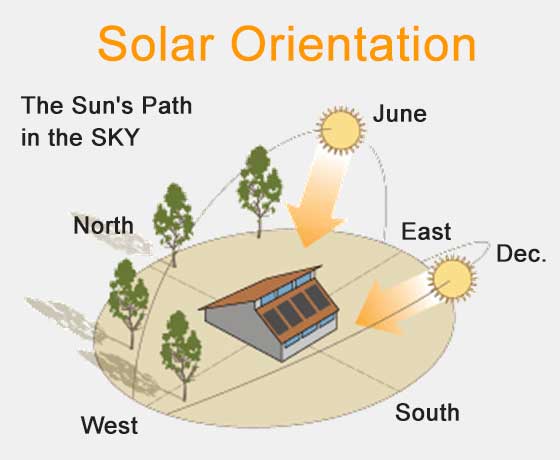
Siting Your Solar Water System
Siting Your Solar Water Heating System
Before you buy and install a solar water heating system, you need to first consider your site's solar resource, as well as the optimal orientation and tilt of your solar collector. The efficiency and design of a solar water heating system depends on how much of the sun's energy reaches your building site.
Solar water heating systems use both direct and diffuse solar radiation. Even if you don't live in a climate that's warm and sunny most of the time, your site still might have an adequate solar resource. If your building site has unshaded areas and generally faces south, it's a good candidate for a solar water heating system. Your local solar system supplier or installer can perform a solar site analysis.
Both the orientation and tilt of the collector will affect your solar water heating system's performance. Your contractor should consider both factors while evaluating your site's solar resource and sizing your system.
Collector Orientation

Solar hot water collectors should be oriented geographically to maximize the amount of daily and seasonal solar energy that they receive. In general, the optimum orientation for a solar collector in the northern hemisphere is true south. However, recent studies have shown that, depending on your location and collector tilt, your collector can face up to 90º east or west of true south without significantly decreasing its performance.
You'll also want to consider factors such as roof orientation (if you plan to mount the collector on your roof), local landscape features that shade the collector daily or seasonally, and local weather conditions (foggy mornings or cloudy afternoons), as these factors may affect your collector's optimal orientation.
Collector Tilt

Today, most solar water heating collectors are mounted flat on the roof. This is more aesthetically pleasing than rack-mounted collectors, which stick up from the roof at odd angles. Thus, most collectors have the same tilt as the roof.
Although the optimal tilt angle for your collector is an angle equal to your latitude, fixing your collector flat on an angled roof will not result in a big decrease in system performance. You will, however, want to take roof angle into account when sizing your system.
Before you buy and install a solar water heating system, you need to first consider your site's solar resource, as well as the optimal orientation and tilt of your solar collector. The efficiency and design of a solar water heating system depends on how much of the sun's energy reaches your building site.
Solar water heating systems use both direct and diffuse solar radiation. Even if you don't live in a climate that's warm and sunny most of the time, your site still might have an adequate solar resource. If your building site has unshaded areas and generally faces south, it's a good candidate for a solar water heating system. Your local solar system supplier or installer can perform a solar site analysis.
Both the orientation and tilt of the collector will affect your solar water heating system's performance. Your contractor should consider both factors while evaluating your site's solar resource and sizing your system.
Collector Orientation

Solar hot water collectors should be oriented geographically to maximize the amount of daily and seasonal solar energy that they receive. In general, the optimum orientation for a solar collector in the northern hemisphere is true south. However, recent studies have shown that, depending on your location and collector tilt, your collector can face up to 90º east or west of true south without significantly decreasing its performance.
You'll also want to consider factors such as roof orientation (if you plan to mount the collector on your roof), local landscape features that shade the collector daily or seasonally, and local weather conditions (foggy mornings or cloudy afternoons), as these factors may affect your collector's optimal orientation.
Collector Tilt

Today, most solar water heating collectors are mounted flat on the roof. This is more aesthetically pleasing than rack-mounted collectors, which stick up from the roof at odd angles. Thus, most collectors have the same tilt as the roof.
Although the optimal tilt angle for your collector is an angle equal to your latitude, fixing your collector flat on an angled roof will not result in a big decrease in system performance. You will, however, want to take roof angle into account when sizing your system.

